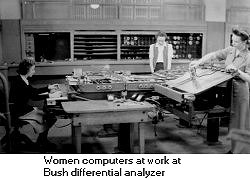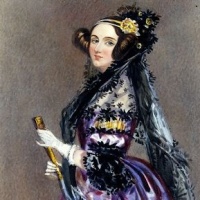

In the early 1940s computers were not machines, they were young women who toiled 16 hours a day calculating the data for the settings in artillery and bomb-sights.
Almost 200 of them worked in secret at the Moore School of Engineering of the University of Pennsylvania
They also wrote the programs for ENIAC - the first ever programmable digital computer, which weighed 13 tons!
 After Pearl Harbor, it became urgent to calculate the data for more accurate settings of artillery and for the bomb sights used for dropping bombs on enemy targets.
After Pearl Harbor, it became urgent to calculate the data for more accurate settings of artillery and for the bomb sights used for dropping bombs on enemy targets.
Hitherto, gunners adjusted the range and azimuth with crude dials, then started firing, making adjustments under the guidance of spotters who reported how the shells had landed, a great waste of ammunition and a delay in reaching the target.
Before the war, the Army was working on new artillery weapons at its Ballistic Research Laboratory at the Aberdeen Proving Ground in Maryland. They used a Bush differential analyzer, a 30-foot-long mechanical calculating machine developed by MIT's Vannevar Bush, to crunch the numbers needed to operate these weapons efficiently and also a team of human computers who compiled tables, using pencil, paper, and mechanical adding machines.
After Pearl Harbor it became urgent to complete this task and the Army enlisted the resources (and the additional differential analyzer) of the University of Pennsylvania's Moore Engineering School. An SOS was sent to the principals of high schools in the Philadelphia and Baltimore area, later also in neighboring states. As young men were being inducted into the Armed Forces, girls who had high scores in mathemetics were called upon to perform this important work.
 Capt. Herman Goldstine and his wife Adele (also a gifted mathematician), and Mary Mauchly, wife of Moore School professor John Mauchly, were the instructors who taught the scores of young women who volunteered for the project. They had to learn the specialized mathematical differentiation and integration techniques involved in ballistics calculations, then carry out the thousands of intricate calculations to make up the Firing Tables, each designed for a specific weapon. Settings were calculated for different ranges to target, wind velocities, barometric pressures, etc.
Capt. Herman Goldstine and his wife Adele (also a gifted mathematician), and Mary Mauchly, wife of Moore School professor John Mauchly, were the instructors who taught the scores of young women who volunteered for the project. They had to learn the specialized mathematical differentiation and integration techniques involved in ballistics calculations, then carry out the thousands of intricate calculations to make up the Firing Tables, each designed for a specific weapon. Settings were calculated for different ranges to target, wind velocities, barometric pressures, etc.
Their work was classifed "Top Secret" and they were not allowed to talk to anyone about their work. While the women who worked in the munitions industries were widely publicized under the name "Rosie the Riveter", the women computers who labored in 16 hour shifts to produce the Firing Tables were unknown. After the war they were completely forgotten.
 It took a woman computer working with a desk calculator about 20 hours to compute a single 60 second trajectory. The analog differential analyzer produced the same result in 15 minutes, but the set up for any individual calculation was time consuming. In 1943 under the direction of Capt. Goldstine, Dr.John Mauchly and engineer J. P. Eckert, Jr prepared a proposal for a programmable digital computing machine that would be much faster. The work was carried out at the Moore School of the University of Pennsylvania and completed February 15, 1946.
It took a woman computer working with a desk calculator about 20 hours to compute a single 60 second trajectory. The analog differential analyzer produced the same result in 15 minutes, but the set up for any individual calculation was time consuming. In 1943 under the direction of Capt. Goldstine, Dr.John Mauchly and engineer J. P. Eckert, Jr prepared a proposal for a programmable digital computing machine that would be much faster. The work was carried out at the Moore School of the University of Pennsylvania and completed February 15, 1946.
ENIAC (Electronic Numerical Integrator And Computer) consisted of thirty separate units, and weighed over thirty tons. Its 19,000 vacuum tubes, 1,500 relays, and hundreds of thousands of resistors, capacitors, and inductors consumed almost 200 kilowatts of electrical power. However it took only 30 seconds to calculate a trajectory, instead of the 20 hours with pencil and paper. Needless to say, modern super-computers perform the same task in milliseconds.
No programs existed at the time.The extraordinarily complex work of programming the ENIAC from scratch was performed largely by six members of the University's women computers: Kay McNulty, Betty Jennings, Betty Snyder, Marlyn Wescoff, Fran Bilas and Ruth Lichterman. Their work was secret and at the time was unrecognized. In fact, when ENIAC was made public in 1946, they were not mentioned. Even in photographs of ENIAC released to the press, they were air-brushed out of the picture! Belatedly, they were inducted into the Women in Technology International Hall of Fame in 1997.
Their work was secret and at the time was unrecognized. In fact, when ENIAC was made public in 1946, they were not mentioned. Even in photographs of ENIAC released to the press, they were air-brushed out of the picture! Belatedly, they were inducted into the Women in Technology International Hall of Fame in 1997.
These computer girls followed in the footsteps of another largely forgotten woman programmer Ada Lovelace, daughter of the poet Lord Byron, who designed the first ever computer programs for the Babbage computing engine in the 1840s, 100 years earlier!
Return to top of page.
Go to Index to computer references.
Photos courtesy of American Heritage Magazine - 2011, Issue 2 except where noted.
Digital computers, a brief history.
The story of ENIAC,
first digital computer.
Women in Technology International Hall of Fame.
